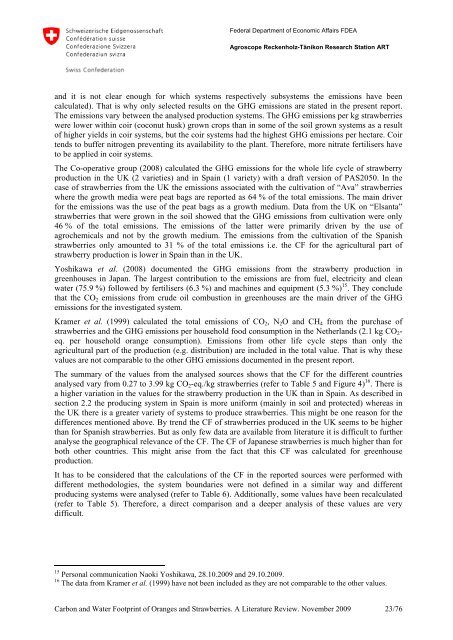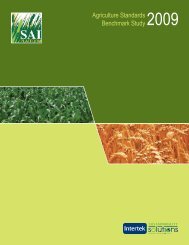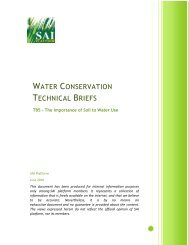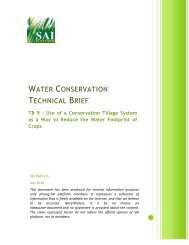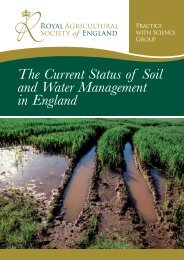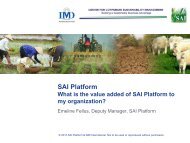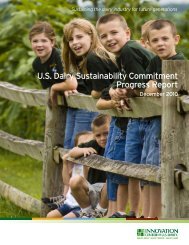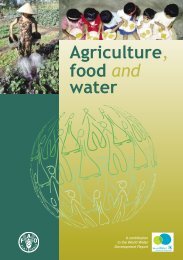Carbon & Water Footprint of Oranges and Strawberries - SAI Platform
Carbon & Water Footprint of Oranges and Strawberries - SAI Platform
Carbon & Water Footprint of Oranges and Strawberries - SAI Platform
You also want an ePaper? Increase the reach of your titles
YUMPU automatically turns print PDFs into web optimized ePapers that Google loves.
Federal Department <strong>of</strong> Economic Affairs FDEA<br />
Agroscope Reckenholz-Tänikon Research Station AR T<br />
<strong>and</strong> it is not clear enough for which systems respectively subsystems the emissions have been<br />
calculated). That is why only selected results on the GHG emissions are stated in the present report.<br />
The emissions vary between the analysed production systems. The GHG emissions per kg strawberries<br />
were lower within coir (coconut husk) grown crops than in some <strong>of</strong> the soil grown systems as a result<br />
<strong>of</strong> higher yields in coir systems, but the coir systems had the highest GHG emissions per hectare. Coir<br />
tends to buffer nitrogen preventing its availability to the plant. Therefore, more nitrate fertilisers have<br />
to be applied in coir systems.<br />
The Co-operative group (2008) calculated the GHG emissions for the whole life cycle <strong>of</strong> strawberry<br />
production in the UK (2 varieties) <strong>and</strong> in Spain (1 variety) with a draft version <strong>of</strong> PAS2050. In the<br />
case <strong>of</strong> strawberries from the UK the emissions associated with the cultivation <strong>of</strong> “Ava” strawberries<br />
where the growth media were peat bags are reported as 64 % <strong>of</strong> the total emissions. The main driver<br />
for the emissions was the use <strong>of</strong> the peat bags as a growth medium. Data from the UK on “Elsanta”<br />
strawberries that were grown in the soil showed that the GHG emissions from cultivation were only<br />
46 % <strong>of</strong> the total emissions. The emissions <strong>of</strong> the latter were primarily driven by the use <strong>of</strong><br />
agrochemicals <strong>and</strong> not by the growth medium. The emissions from the cultivation <strong>of</strong> the Spanish<br />
strawberries only amounted to 31 % <strong>of</strong> the total emissions i.e. the CF for the agricultural part <strong>of</strong><br />
strawberry production is lower in Spain than in the UK.<br />
Yoshikawa et al. (2008) documented the GHG emissions from the strawberry production in<br />
greenhouses in Japan. The largest contribution to the emissions are from fuel, electricity <strong>and</strong> clean<br />
water (75.9 %) followed by fertilisers (6.3 %) <strong>and</strong> machines <strong>and</strong> equipment (5.3 %) 15 . They conclude<br />
that the CO 2 emissions from crude oil combustion in greenhouses are the main driver <strong>of</strong> the GHG<br />
emissions for the investigated system.<br />
Kramer et al. (1999) calculated the total emissions <strong>of</strong> CO 2 , N 2 O <strong>and</strong> CH 4 from the purchase <strong>of</strong><br />
strawberries <strong>and</strong> the GHG emissions per household food consumption in the Netherl<strong>and</strong>s (2.1 kg CO 2 -<br />
eq. per household orange consumption). Emissions from other life cycle steps than only the<br />
agricultural part <strong>of</strong> the production (e.g. distribution) are included in the total value. That is why these<br />
values are not comparable to the other GHG emissions documented in the present report.<br />
The summary <strong>of</strong> the values from the analysed sources shows that the CF for the different countries<br />
analysed vary from 0.27 to 3.99 kg CO 2 -eq./kg strawberries (refer to Table 5 <strong>and</strong> Figure 4) 16 . There is<br />
a higher variation in the values for the strawberry production in the UK than in Spain. As described in<br />
section 2.2 the producing system in Spain is more uniform (mainly in soil <strong>and</strong> protected) whereas in<br />
the UK there is a greater variety <strong>of</strong> systems to produce strawberries. This might be one reason for the<br />
differences mentioned above. By trend the CF <strong>of</strong> strawberries produced in the UK seems to be higher<br />
than for Spanish strawberries. But as only few data are available from literature it is difficult to further<br />
analyse the geographical relevance <strong>of</strong> the CF. The CF <strong>of</strong> Japanese strawberries is much higher than for<br />
both other countries. This might arise from the fact that this CF was calculated for greenhouse<br />
production.<br />
It has to be considered that the calculations <strong>of</strong> the CF in the reported sources were performed with<br />
different methodologies, the system boundaries were not defined in a similar way <strong>and</strong> different<br />
producing systems were analysed (refer to Table 6). Additionally, some values have been recalculated<br />
(refer to Table 5). Therefore, a direct comparison <strong>and</strong> a deeper analysis <strong>of</strong> these values are very<br />
difficult.<br />
15 Personal communication Naoki Yoshikawa, 28.10.2009 <strong>and</strong> 29.10.2009.<br />
16 The data from Kramer et al. (1999) have not been included as they are not comparable to the other values.<br />
<strong>Carbon</strong> <strong>and</strong> <strong>Water</strong> <strong>Footprint</strong> <strong>of</strong> <strong>Oranges</strong> <strong>and</strong> <strong>Strawberries</strong>. A Literature Review. November 2009 23/76


